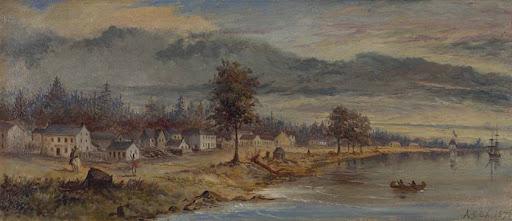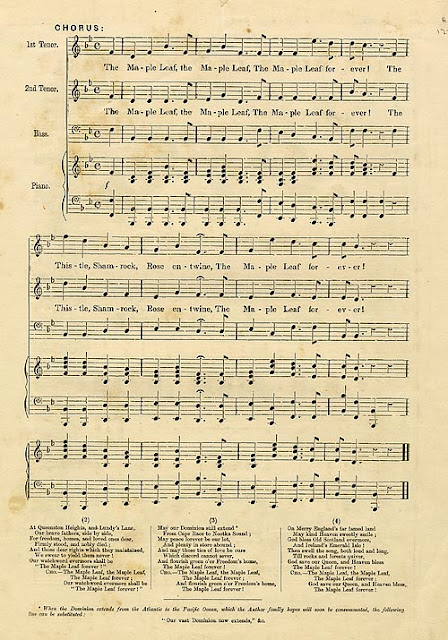A piece of historic Canadian patriotic music that has all but disappeared, except for when it is heard in the days leading up to the commemoration of Canadian Confederation each year, has several associations with Toronto. The song, of course, is "The Maple Leaf Forever". The composer of this traditional Canadian fanfare was Alexander Muir, who was a longtime resident of this city. Like Canada's first Prime Minister, Macdonald, and Toronto's first Mayor, Mackenzie ~ indeed like so many others who formed the early backbone of both Toronto and Canada ~ Muir was a Scotsman. Born in Lesmahagow, in south-central Scotland, in 1830, Muir soon arrived in the Toronto region, brought over by his family. Indeed, he arrived here in 1833, just one year before Toronto became a city. No doubt, he had little memory of the festivities that accompanied our incorporation into Toronto, and the passing away of the old Town of York.
Muir received his early education at home, from his father, but later graduated from Queen's College. Muir would go on to become a model resident of Toronto, especially given the times in which he lived. He became a school teacher, presiding over classrooms in central Toronto, as well as in what were then much more suburban areas like Scarborough, Parkdale, and Leslieville. He served for a time in the Toronto based Queen's Own Rifles, and fought against invading Fenians at the Battle of Ridgeway. Muir was active in the Loyal Orange Lodge, and was no doubt tempted to combine his philosophies as a member of this fraternal organization with his memories of active military service, by decrying the "evils" of Irish Catholicism in the classroom. If he ever gave in to temptation, he would have been in good company. George Brown, another Scotsman and one of Canada's founding fathers (as well as the father of the modern day Liberal Party of Canada and what is now the Globe and Mail newspaper) was known for his anti-Catholic views. Most of Toronto, which had, after all, been nickamed "The Belfast of Canada" was staunchly and rabidly Protestant.
 |
| THEN : Alexander Muir, 1830 to 1906. |
According to some accounts, Muir penned "The Maple Leaf Forever" while serving against the Fenians at Ridgeway in 1866. According to other versions, he was inspired by a maple tree that stood on the front lawn of his cottage at Toronto's Memory Lane and Laing Street, while he was engaged as a teacher in Leslieville. Some highly romanticized versions even have a maple leaf fluttering down on to the pages of his composition book, thus breaking up the writer's block that Muir was experiencing while trying to submit an entry into a patriotic song writing competition. The song soon became popular, and was an unofficial anthem for years.
 |
| THEN : John McPherson's 1907 painting of Muir's house in Leslieville. |
A maple tree on the southwest corner of Laing Street and Memory Lane (located one block south of Queen Street) is stated by legend to be the tree from which Muir took inspiration for his famous composition. A plaque erected in 1958 by the Grand Orange Lodge of British America plaque is pictured here (as is the actual tree, shown in the second photograph below).
What kept Muir's ballad from every becoming official was the fact that the lyrics were seen as very strongly "pro-British", and therefore, anti-French Canadian. The song did meet with unpopularity in French speaking Canada, despite the addition of a reference to the French lily in the lyrics. Indeed there have been assertions that the lily was included in the original lyrics. Muir himself lamented that there was such criticism to his song, and expressed his desire to represent the union of both French and English speaking Canadians under a national banner. However, a desire to appease remained, and "The Maple Leaf Forever" never became an official Canadian anthem, although it was often a de facto one. Officialdom for the song has been granted in its acceptance as the official regimental march for the Queen's Own Rifles, as well as for the Royal Westminster Regiment, from Westminster, British Columbia.
 |
| THEN : The original cover and (below) sheet music to Muir's "The Maple Leaf Forever" |
There have been several alternative versions of "The Maple Leaf Forever" in the almost 150 years since it was written. Fifteen years ago, in 1997, it was rewritten by Vladimir Radian, a mathematician-turned-songwriter who was originally from Romania. Radian penned his lyrics in response to a contest held by CBC Radio, and his version was played in concert by the Toronto Symphony Orchestra in June of 1997. All those mid-nineteenth century references to our British traditions and "colonial" past were removed in this new version.
Radian's version was one of many revisions in recent years. Anne Murray sang a modified version of Radian's lyrics at the final game in Maple Leaf Gardens. Her version was used by Michael Buble at the 2010 Winter Olympics. In 2008, a Scottish-Canadian celtic punk rock band called "The Real McKenzies" did a send up of "The Maple Leaf Forever," and even altered the name of the song to "The Maple Trees Remember".
Whatever happened to Alexander Muir? He died on June 26, 1906, and is buried in Toronto's Mount Pleasant Cemetery.
 |
| NOW : The gravesite of Alexander Muir, in Toronto's Mount Pleasant Cemetery. |
There are several commemorations of Muir in Toronto and across Canada. The Alexander Muir Memorial Gardens are located on the east side of Yonge Street, just south of Lawrence Avenue. Maple Leaf Forever Park is near Muir's Leslieville home, in the Leslie Street / Queen Street east neighbourhood. Alexander Muir / Gladstone Avenue Jr and Sr Public School, on Gladstone Avenue, is just one scholastic commemoration of Muir. Alexmuir Jr Public School is in Scarborough (on Alexmuir Boulevard) and Alexander Muir Public School is in Newmarket. Outside Ontario, Albert's Mount Muir is another commemoration.
So, take your pick this Canada Day - original lyrics, later twentieth century remake, or punk lyrics, have a fun and safe Canada Day!
________________________
The "original" version of "The Maple Leaf Forever"
In days of yore, from Britain's shore,
Wolfe, the dauntless hero, came
And planted firm, Britannia's flag
On Canada's fair domain.
Here may it wave, our boast, our pride,
And joined in love together,
The thistle, shamrock, rose entwine
The Maple Leaf Forever!
Chorus:
The Maple Leaf, our emblem dear,
The Maple Leaf, forever!
God save our Queen, and Heaven bless
The Maple Leaf forever!
At Queenston Heights and Lundy's Lane
Our brave fathers, side by side,
For freedom, homes and loved ones dear,
Firmly stood and nobly died;
And those dear rights which they maintained,
We swear to yield then never!
Our watchward ever more shall be
"The Maple Leaf forever!"
Chorus
Our fair Dominion now extends
From Cape Race to Nootka Sound;
May peace forever be our lot,
And plenteous store abound:
And may those ties of love be ours
Which discord cannot sever,
And flourish green o'er freedom's home
The Maple Leaf forever!
Chorus
On merry England's far famed land
May kind heaven sweetly smile,
God bless old Scotland evermore
and Ireland's Em'rald Isle!
And swell the song both loud and long
Till rocks and forest quiver!
God Save our Queen and Heaven bless
The Maple Leaf Forever!
Chorus






I believe that I will be delighted to review your posts. For now to let you know, I discovered via Google several of your photos (your post #29), which are very a propos to my research into the Maple Leaf Forever. My historical interests are much lighter-weight than yours, but you might be amused by "Giorgio's Ukable Parodies" at www.ukableparodies.blogspot.com
ReplyDeleteG. C.
Alexander Muir is my Great Great Grandfather He was very famous because of The Maple Leaf Forever. He won a humble prize for his efforts in 1867. He went far and wide to promote his song and performed it frequently and was a very proud Canadian. The city of Toronto has honoured him with 2 parks with his name the first at Yonge and Davisville within eyesite of his grave in Mount Pleasant Cemetery unfortunately they had to move this Garden to Yonge and Lawrence to accommodate the new Toronto subway.. The gardens are beautiful. Seeing as it is the 150 anniversary of this very Canadian patriotic song I would find it fitting the Royal Canadian Mint issue a coin His song has best promoted the Mapleleaf our emblem best in the past 150 years 1867-2017.
ReplyDeletel
Does anyone know of a French version of this song?
ReplyDelete